New Jersey is also called “The Garden State,” primarily thanks to its status as one of the country’s leaders in agricultural production. Reportedly, the state is home to more than 2,000 plant species. Therefore, we can safely state that New Jersey is a true natural gem, plants included!
Let’s learn more about plants native to New Jersey.
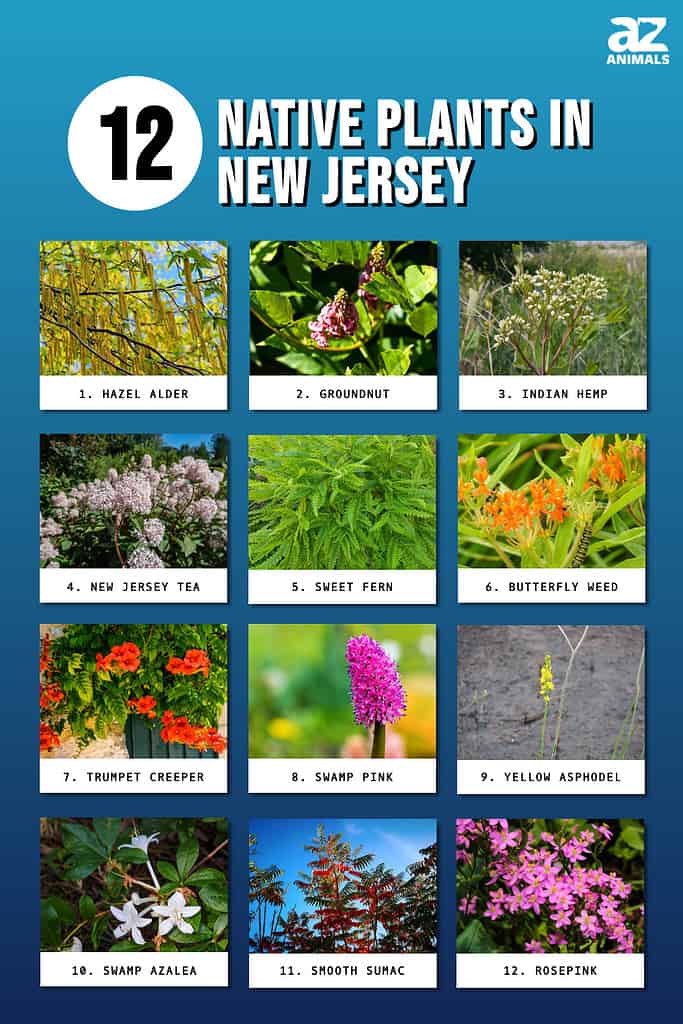
1. Hazel Alder
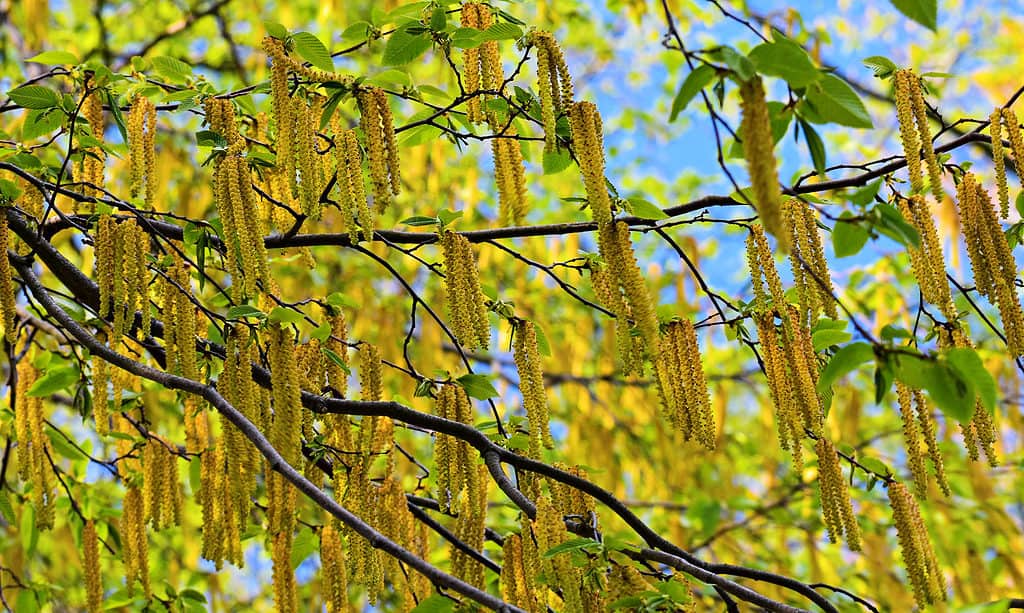
Hazel alder produces cone-like fruits that mature during fall.
©Gabriela Beres/Shutterstock.com
| Hazel Alder | |
|---|---|
| Scientific name | Alnus serrulata |
| Other common names | Smooth alder |
| Type of plant | Thicket-forming shrub or small tree |
| Distribution | Eastern North America |
| Uses | Habitat stabilizer and restorer; used in diuretic, ophthalmic, and purgative treatments |
Hazel alder, also called smooth alder, can grow as a shrub or small tree, and it usually reaches around 13 feet in height and 5.9 inches in diameter. Its bark is smooth and brownish-gray, while the twigs are reddish-brown and covered with hairs when young.
It has simple, obovate leaves measuring up to 5 inches long and around 3 inches wide. The reddish-green flowers open in March or April. Hazel alder produces cone-like fruits that mature during fall.
This plant is often spotted in aquatic habitats, nearby swamps, or streambanks because it requires sunny and moist environments.
2. Groundnut

Groundnut is also called potato bean because its tubers are similar to potatoes in nutritional content.
©ChWeiss/Shutterstock.com
| Groundnut | |
|---|---|
| Scientific name | Apios americana |
| Other common names | American groundnut, Indian potato, hodoimo, America-hodoimo, potato bean, cinnamon vine |
| Type of plant | Perennial vine |
| Distribution | From southern Canada south to Florida and west to Colorado |
| Uses | Tubers and seeds are often cooked and eaten |
The groundnut is a perennial vine growing up to roughly 19.5 feet long and producing 3-6-inch leaves with 5-7 leaflets. It has beautiful pinkish, red-brown, or purple flowers.
This vine is widely known for its tubers that are cooked and eaten, and it was a staple food for many Indigenous populations in America. Later, the “recipe” was passed to Europeans, playing an important role in the historical relationship between Europe and the American colonies.
Groundnut is also called potato bean because its tubers are similar to potatoes in nutritional content. However, groundnut tubers have a slightly different taste and three times more protein than potatoes.
3. Indian Hemp
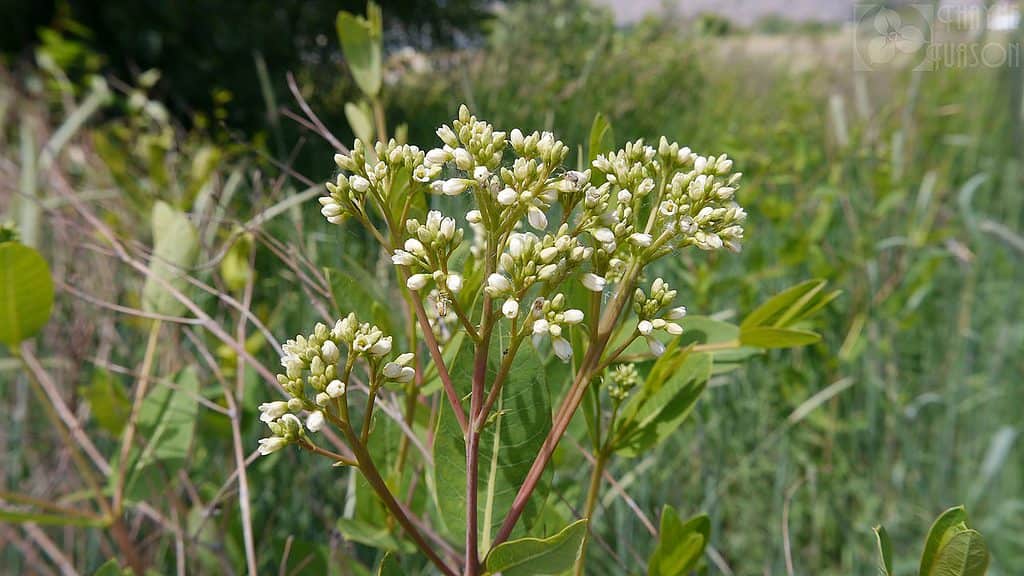
The Indian hemp herbaceous plant has reddish stems and grows up to 3 feet 3 inches tall.
©Thayne Tuason / CC BY 4.0, , via Wikimedia Commons – License
| Indian Hemp | |
|---|---|
| Scientific name | Apocynum cannabinum |
| Other common names | Dogbane, hemp dogbane, prairie dogbane, rheumatism root, amy root, wild cotton |
| Type of plant | Perennial herbaceous |
| Distribution | North America in open wooded areas, hillsides, and ditches |
| Uses | Stalks are a source of fiber for producing clothing, bags, and bows; ground seeds are added to meals; herbal medicine used to treat fever and slow the pulse. |
The Indian hemp herbaceous plant has reddish stems and grows up to 3 feet 3 inches tall. Its stems contain a milky latex that can turn into gum and be used as chewing gum. Its leaves are smooth on top and hairy on the underside, while the flowers have five petals and bloom from July to August.
All plant parts are poisonous to cats, dogs, horses, and humans. Moreover, Indian hemp contains cardiac glycosides — organic compounds that decrease the heart rate. Its stems can cause skin blisters because of their white sap.
Nevertheless, the plant is still useful in various fields. For example, Native Americans used Indian hemp stalks to produce bows, nets, bags, or clothing. Moreover, the seeds can be eaten if ground into powder, while the plant root was used in cardiotonic, diuretic, and emetic treatments.
4. New Jersey Tea
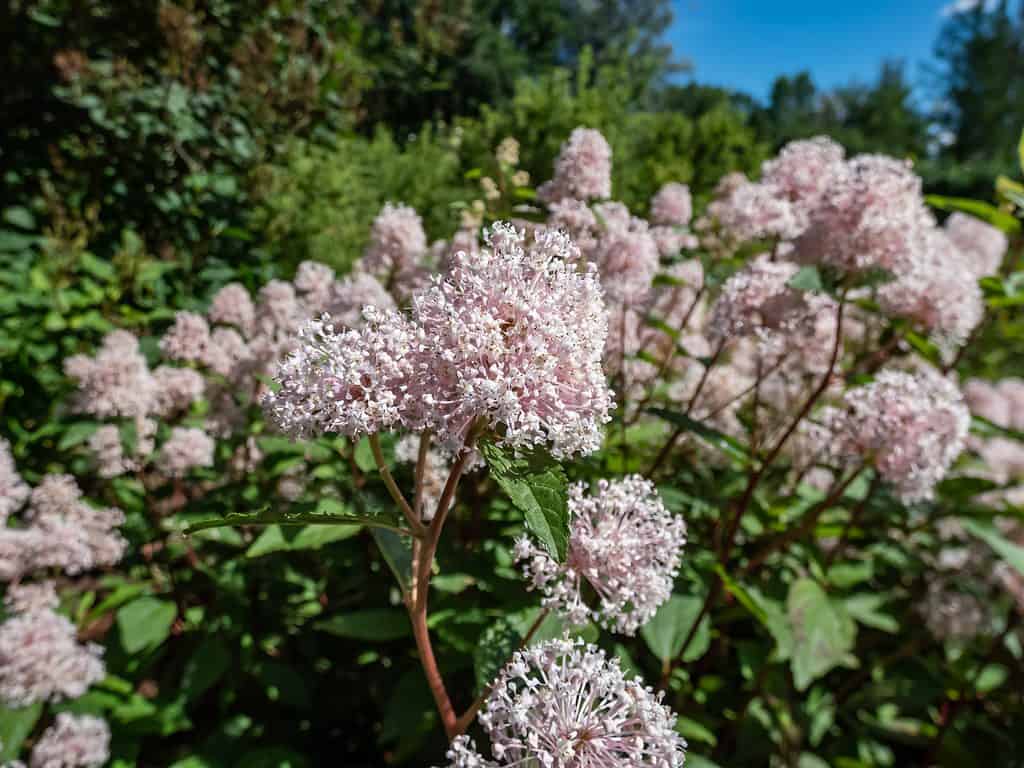
The New Jersey tea has a thick root system with deep, stout, woody roots and fibrous root hairs close to the surface.
©Kristine Rad/Shutterstock.com
| New Jersey Tea | |
|---|---|
| Scientific name | Ceanothus americanus |
| Other common names | Red root, mountain sweet, Jersey tea ceanothus, wild snowball |
| Type of plant | Shrub |
| Distribution | North America |
| Uses | Roots and root bark are used to treat upper respiratory tract infections; root bark is also used to treat lymph system problems. |
The New Jersey tea shrub grows up to 42 inches tall and has a thick root system with deep, stout, woody roots and fibrous root hairs close to the surface. The shrub produces white flowers and dry, dehiscent fruits. This shrub thrives in sandy or rocky soils on dry plains or prairies.
Native Americans used New Jersey tea roots and root bark to treat upper respiratory tract infections. European colonizers used its leaves as a tea substitute, while nowadays, herbalists use root bark to treat lymph system problems. Moreover, some people use flower extracts as dyes.
5. Sweet Fern
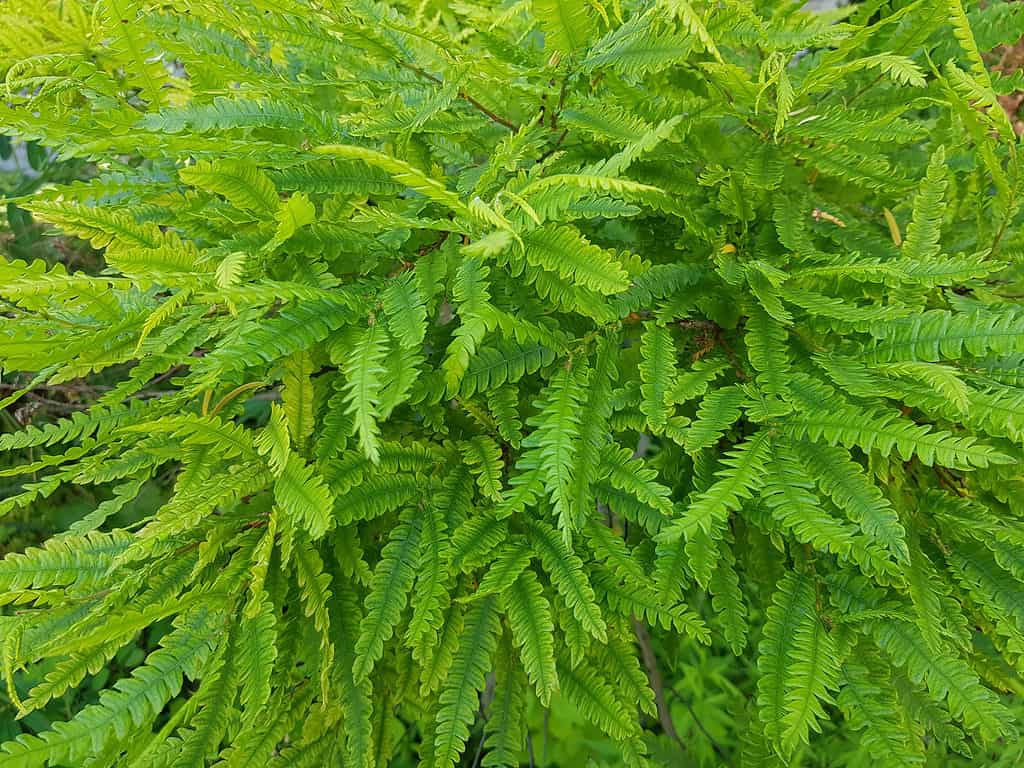
Sweet fern leaves are widely used to make tea, having a pleasant resinous, bitter taste.
©guentermanaus/Shutterstock.com
| Sweet Fern | |
|---|---|
| Scientific name | Comptonia peregrina |
| Type of plant | Flowering deciduous shrub |
| Distribution | North America; grows on dry sandy sites |
| Uses | Leaves are used to make tea |
Although called sweet fern, the Comptonia peregrina plant is not a fern but a flowering plant. In Quebec, it’s called comptonie voyageuse, which translates as “traveling comptonia.”
It’s a flowering deciduous shrub reaching up to 4.9 feet tall. It has linear to lanceolate leaves that give off a sweet odor. The flowers are small, reaching only 0.2 inches long, and grow in clusters. However, when the fruits are formed, the flowers grow longer, up to around 2 inches.
Sweet fern leaves are widely used to make tea, having a pleasant resinous, bitter taste. Some people reported that tea made of sweet fern leaves treats the local effects of poison ivy.
6. Butterfly Weed
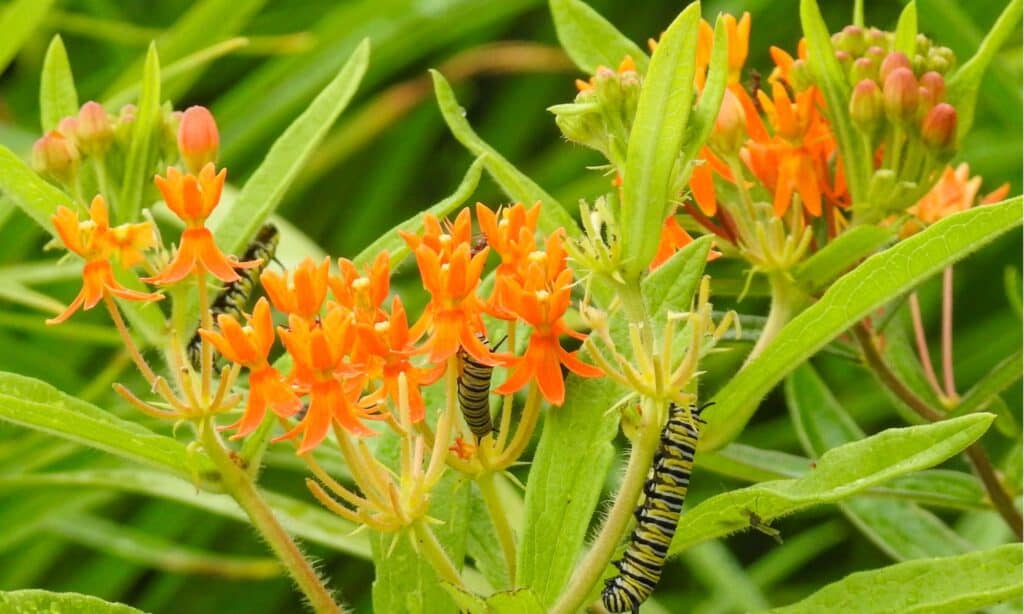
Butterfly
weed grows best in dry, gravel, or sandy soil and requires full sun.
©iStock.com/Catherine Egger
| Butterfly Weed | |
|---|---|
| Scientific name | Asclepias tuberosa |
| Type of plant | Milkweed perennial plant |
| Distribution | Eastern and southwestern North America |
| Uses | Roots were used to treat respiratory diseases and diarrhea. |
Butterfly weed is a milkweed plant, meaning it’s a plant whose latex contains cardiac glycosides that make the plant toxic. Moreover, it contains alkaloids and resinoids that can cause seizures, corneal injuries, or weakness.
Butterfly weed plants grow up to 3.5 feet tall and produce orange, red, or yellow flowers from April to September. These plants have spirally arranged, lanceolate leaves, while the flowers develop five sepals and five petals.
Butterfly weed grows best in dry, gravel, or sandy soil and requires full sun. Although it’s considered toxic and contraindicated in pregnancy or during lactation, Native Americans widely used butterfly weed boiled roots to treat respiratory illnesses and diarrhea. Moreover, the seed pods were boiled and used as a food source.
7. Trumpet Creeper

The trumpet creeper is a flowering vine in the
Bignoniaceaefamily.
©iStock.com/Michel VIARD
| Trumpet Creeper | |
|---|---|
| Scientific name | Campsis radicans |
| Other common names | Yellow trumpet vine, hummingbird vine, cow itch vine |
| Type of plant | Flowering vine |
| Distribution | United States, Canada, Europe, and Latin America |
The trumpet creeper is a flowering vine in the Bignoniaceae family. It can reach lengths of up to 33 feet, aggressively covering trees, plants, buildings, or ground trails. It has long leaves that grow up to 7 inches long, each having up to 13 leaflets. Trumpet creeper produces unscented orange or reddish flowers with yellowish throats.
The flowers attract numerous hummingbirds, moths, ants, and bees when they bloom. Besides, many birds nest in this vine’s dense foliage.
Trumpet vine is known to cause contact dermatitis.
8. Swamp Pink
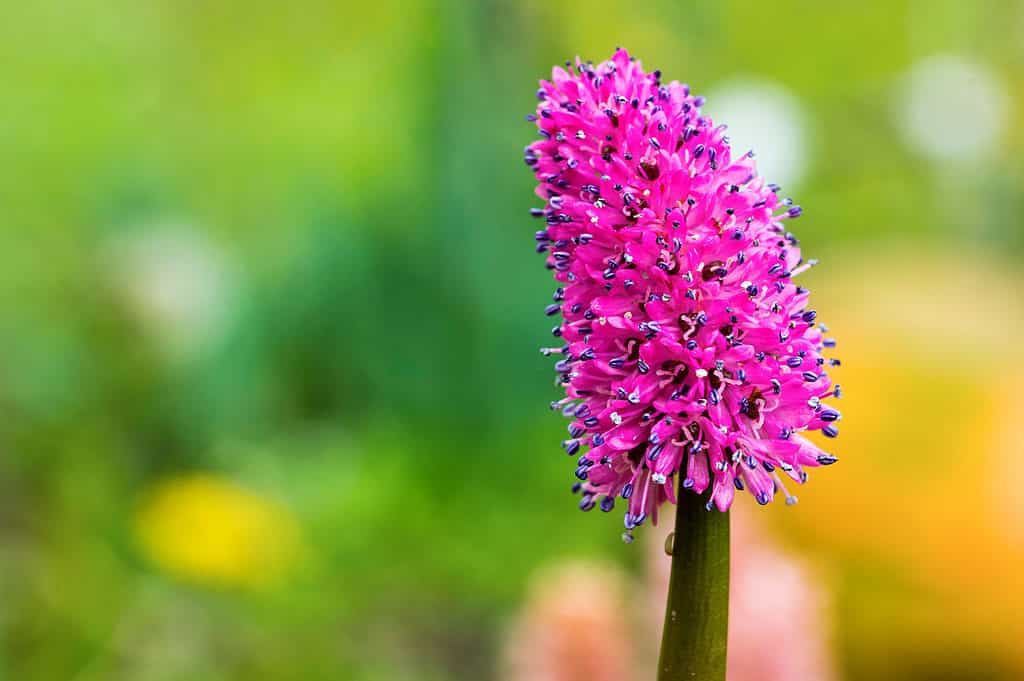
Swamp pink has fragrant pink flowers that bloom from March to May.
©BGphotoaesthetics/Shutterstock.com
| Swamp Pink | |
|---|---|
| Scientific name | Helonias bullata |
| Type of plant | Perennial rhizomatous herb |
| Distribution | Eastern United States |
| Conservation status | Vulnerable |
Swamp pink is a rare plant growing in the eastern United States. It has fragrant pink flowers that bloom from March to May, while the evergreen leaves are parallel-veined, lance-shaped, and dark green to yellow-green.
This species is listed as Vulnerable, and the current largest swamp pink population is in New Jersey. One of the major swamp pink threats is illegal poaching, especially due to its bright pink color. Moreover, since it’s a perennial, it survives winter, making the plant even more attractive to poachers.
9. Yellow Asphodel
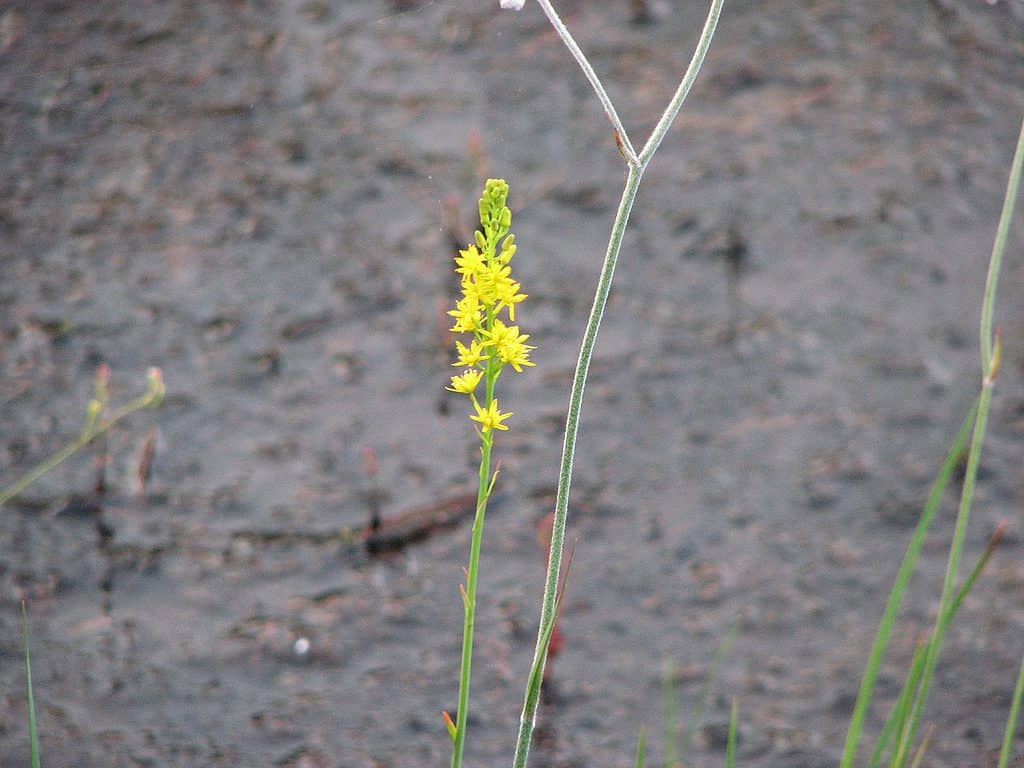
Yellow asphodel is a rhizomatous perennial herb growing in New Jersey’s Pine Barrens.
©Choess / CC BY-SA 3.0, , via Wikimedia Commons – License
| Yellow Asphodel | |
|---|---|
| Scientific name | Narthecium americanum |
| Other common names | Bog asphodel |
| Type of plant | Flowering perennial herb |
| Distribution | In the Pine Barrens of New Jersey |
| Conservation status | Imperiled |
Yellow asphodel is a rhizomatous perennial herb growing in New Jersey’s Pine Barrens. Its stems are around 9.8-17.7 inches tall, while the leaves are roughly 7.8 inches long. In June and July, yellow asphodel produces yellow flowers.
This plant is listed as Imperiled. While it was previously threatened by habitat loss, yellow asphodel is now a protected plant in its habitat. Nevertheless, habitat degradation, off-road vehicles, and beaver dams are still major threats.
10. Swamp Azalea
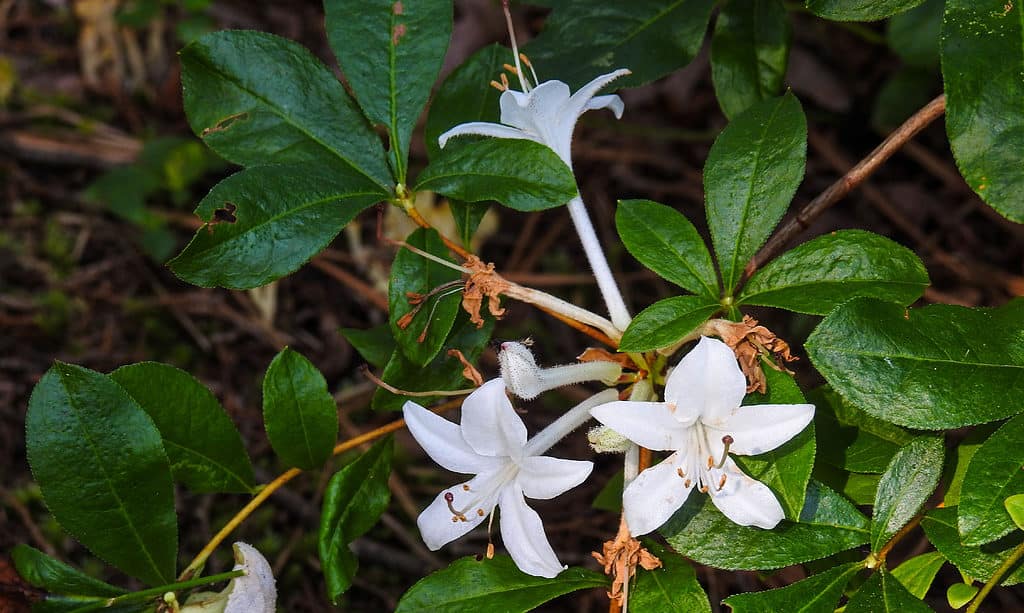
Swamp azalea is a deciduous flowering shrub in the
Ericaceaefamily.
©Scenic Corner/Shutterstock.com
| Swamp Azalea | |
|---|---|
| Scientific name | Rhododendron viscosum |
| Other common names | Clammy azalea, swamp honeysuckle |
| Type of plant | Flowering deciduous shrub |
| Distribution | Eastern United States |
Swamp azalea is a deciduous flowering shrub in the Ericaceae family. It grows to around 8.2 feet tall and wide and has matt green leaves. The shrub blooms in early summer, producing white flowers that turn red-purplish during fall. Besides being extremely beautiful, swamp azalea flowers have a strong scent.
The plant grows in acidic soil enriched with leaf mold and can survive temperatures as low as -4 degrees Fahrenheit.
11. Smooth Sumac
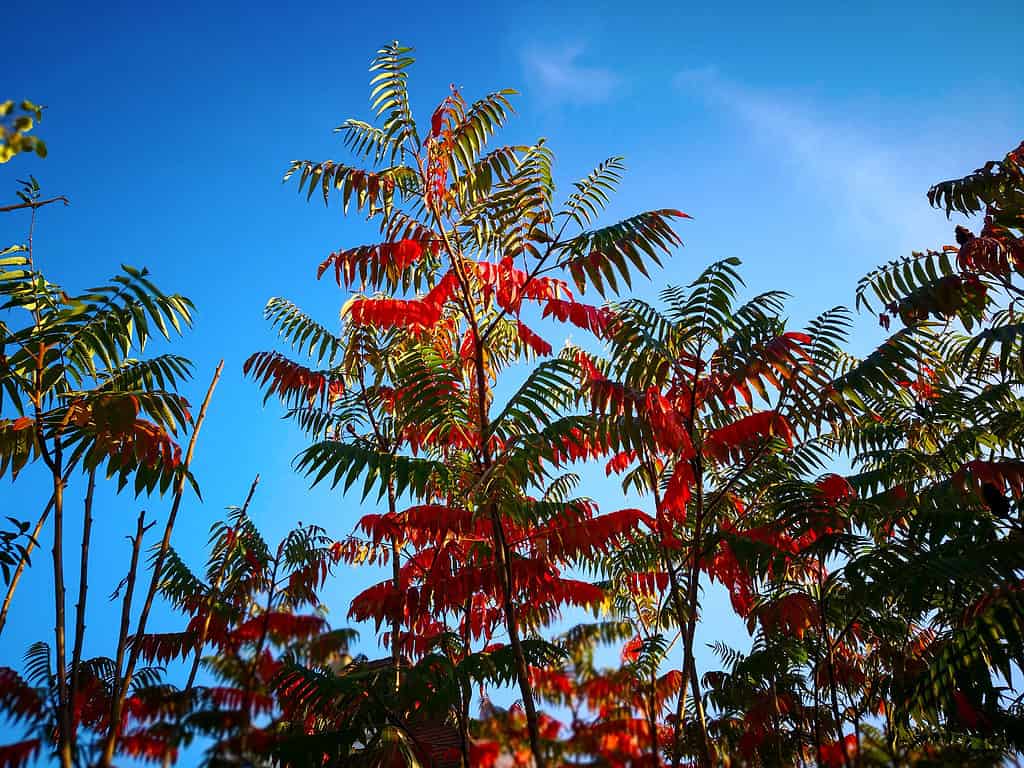
Smooth sumac is a spreading shrub that grows up to 9.8 feet tall.
©Burning Bright/Shutterstock.com
| Smooth Sumac | |
|---|---|
| Scientific name | Rhus glabra |
| Other common names | White sumac, scarlet sumac, upland sumac |
| Type of plant | Shrub |
| Distribution | North America |
| Uses | Sprouts were added to salads; fruits are currently eaten or added to drinks. |
Smooth sumac is a spreading shrub that grows up to 9.8 feet tall. It has alternate leaves and oppositely paired leaflets with serrated margins. It produces small, green flowers during spring and edible crimson berries during summer and autumn. The fruits last throughout winter.
The plant can be found throughout North America and is identified by its smooth, gray-brown bark and fat, hairless twigs. A study shows that it is most common in open areas alongside roads, fences, or woodlands, in rocky or moist soils, and on dry slopes.
12. Rosepink
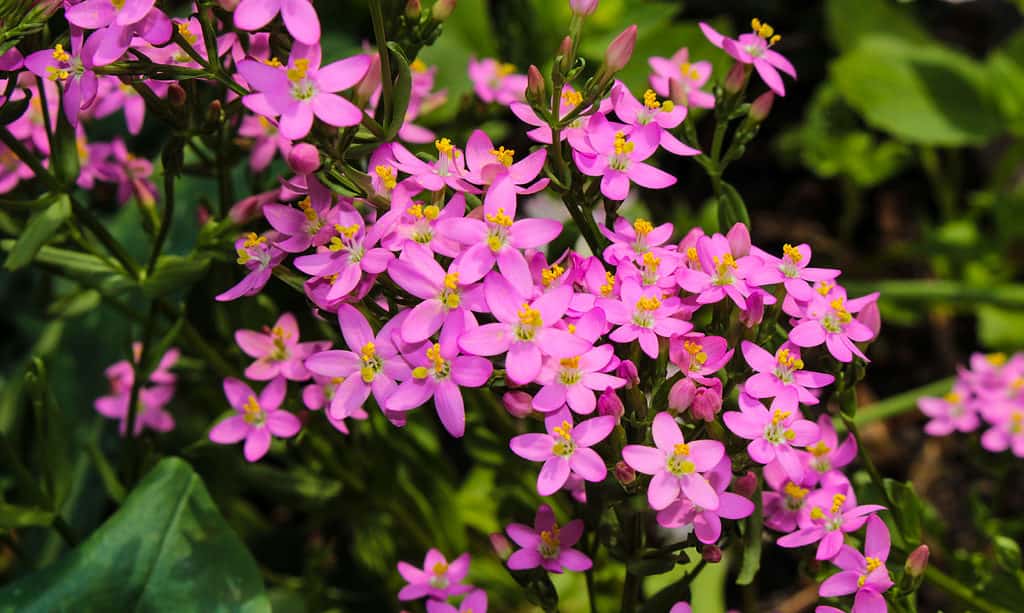
Rosepink leaves are opposite, simple, and ovate to ovate-lanceolate.
©RukiMedia/Shutterstock.com
| Rosepink | |
|---|---|
| Scientific name | Sabatia angularis |
| Other common names | Rose gentain |
| Type of plant | Biennial flowering plant |
| Distribution | United States |
Rosepink plants reach their full height of around 3 feet only in their second year. They have four-sided stems with thin twigs, and the branches grow only on the upper part of the stem. Rosepink leaves are opposite, simple, and ovate to ovate-lanceolate. From June to September, rosepink produces pink flowers with five obovate lobes with yellow markings on their inner edges. Moreover, these gorgeous flowers have a very pleasant scent.
Summary of 12 Native Plants in New Jersey
Here’s a recap of the dozen plants we looked at that are native to the state of New Jersey.
| Number | Plants | Scientific Name | Type of Plant |
|---|---|---|---|
| 1 | Hazel Alder | Alnus serrulata | Thicket-forming shrub or small tree |
| 2 | Groundnut | Apios americana | Perennial vine |
| 3 | Indian Hemp | Apocynum cannabinum | Perennial herbaceous |
| 4 | New Jersey Tea | Ceanothus americanus | Shrub |
| 5 | Sweet Fern | Comptonia peregrina | Flowering deciduous shrub |
| 6 | Butterfly Weed | Asclepias tuberosa | Milkweed perennial plant |
| 7 | Trumpet Creeper | Campsis radicans | Flowering vine |
| 8 | Swamp Pink | Helonias bullata | Perennial rhizomatous herb |
| 9 | Yellow Asphodel | Narthecium americanum | Flowering perennial herb |
| 10 | Swamp Azalea | Rhododendron viscosum | Flowering deciduous shrub |
| 11 | Smooth Sumac | Rhus glabra | Shrub |
| 12 | Rosepink | Sabatia angularis | Biennial flowering plant |
The photo featured at the top of this post is © Kristine Rad/Shutterstock.com
Sources
- ProQuest, Available here: https://www.proquest.com/openview/0056a633f7e00fbe8e1fb1fa19095284/1?pq-origsite=gscholar&cbl=18750&diss=y
- The Native Plant Society of New Jersey, Available here: https://npsnj.org/native-plants/where-to-buy-natives/plant-lists/
Thank you for reading! Have some feedback for us? Contact the AZ Animals editorial team.






